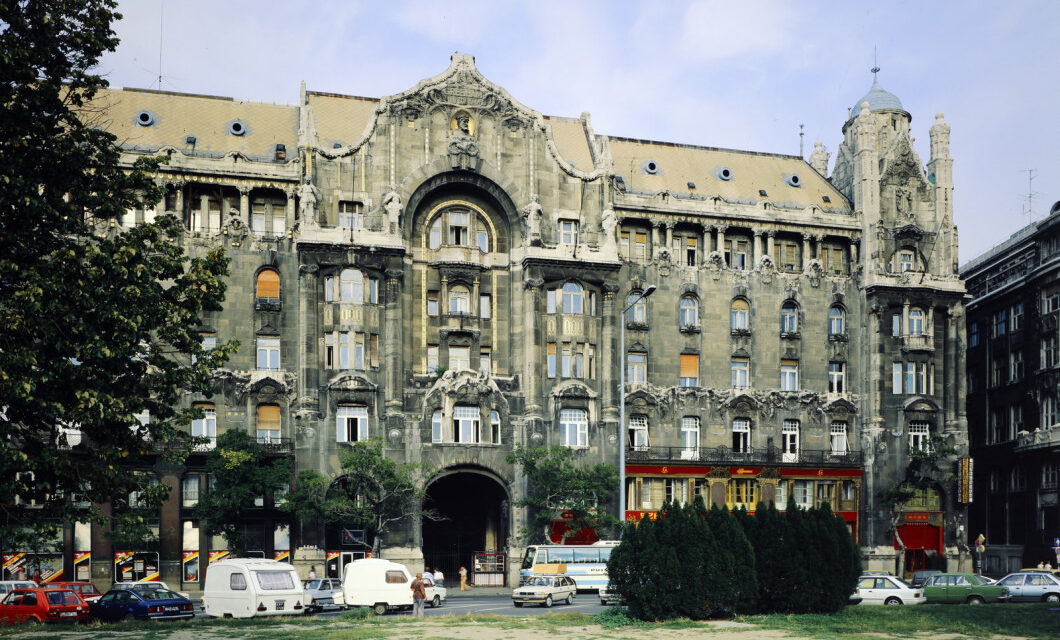Many famous people lived here: Gyula Csortos, Pál Jávor, Márta Egri and Ida Turay, who was the most loyal resident, because they could only start remodeling the building after his death.
The Gresham Palace is part of the Pest skyline, yet we know very little about it. Today it functions as a hotel, although during its long history it provided both a home and a workplace for countless people.
The imposing building has only regained its long-lost splendor in the last little more than twenty years. Once upon a time, the peacock iron gates visible today led to a concreted, dark corridor, where there was no memory of the elegant shops of the 1920s. The elevator was the only one in service, but it by no means evoked the spirit of bygone eras, as it was "decorated" in the style of the '70s. Everyone went where they had to go: someone to their apartment, someone to their workplace. Offices were created on the second and third floors, where I was lucky enough to visit many times as a child. To this day, I can still hear the creaking sound of the worn parquet floors and the creaking of the huge white doors. My parents and grandmother also worked here, and they told me a lot about the famous residents of the palace, many of whom they bumped into:
About Gyula Csortos, Pál Jávor, Márta Egri and Ida Turay, who was the most loyal resident, because they could only start remodeling the building after his death.
The History of Gresham Palace
At the beginning of the 18th century, when its construction began, it was considered important to develop the Lipótváros part of Budapest. Around this time, fairs were regularly organized here, and over time the wealthier residents visited the area more and more often. It was around this time that the need to build a palace was formulated, and it was then that the Ullmann House, the Diana Bath, and the Nákó Palace were built, which stood on the site of today's Gresham Palace. The latter was designed by József Hild for the Nákó family, whose ancestors came from Macedonia as Nakosz and changed their name to Magyar in Pest. The Nákó Palace was the first palace-style apartment building in Pest, with 162 rooms instead. It was an extremely stable building, surviving the great flood of 1838 with minor damage. Finally, in 1872, the family sold it to a bank, which was liquidated shortly afterwards, so the house was sold again in 1880, well below the purchase price, for only HUF 740,000.
The buyer was the Gresham Life Insurance Company, named after Sir Thomas Gresham, a well-known merchant in the 16th century. The London-based company saw the building as outdated over time, although it housed people such as the chief architect of the Chain Bridge, Ádám Clark, or Miklós Barabás, a representative of Hungarian romantic painting.
The Nákó Palace was demolished in 1903, and its successor, the Gresham Palace, was built for three years from 1904. In 1903, the Vállalzók Lapja wrote about the planned building as follows:
"We hear that the new palace will be divided into four parts, with four courtyards and a monumental facade overlooking the Chain Bridge".
The building was designed by Zsigmond Quittner and the Vágó brothers, and they left room for almost every contemporary luxury in it. The finished building did not stand out from the Art Nouveau buildings that dominated the city at the time: wrought iron decorations, animal and plant elements, and mosaics are all echoed in the details of the palace.
The ceramics still visible today were made by the Zsolnay factory in Pécs, the glass windows were the work of Miksa Róth, the facade decorations were ordered by Géza Maróti, and the wrought iron gate was ordered by Gyula Jungfer.
According to a legend, the designer Quittner fell in love with one of the residents of the house, and as a sign of his love, he placed hearts everywhere. Today we can still find these on the facade, the lamp fittings, the window panes...
The building unites four houses, three of which are connected by a ground-floor passage, covered with a glass dome - from here you can go out to three streets. Stairs led from the courtyard to the various buildings: the Andrássy, Kossuth, and Gresham stairs. When it was built, a bazaar row was placed on the ground floor, so it was not only people who lived in the building who went here.
By 1909, the café culture had also reached Budapest, and the Gresham-Venezia opened in the Gresham Palace, which was one of the capital's most defining cafés. Here, the so-called Gresham circle was formed from the artists of the era, about which one of the members, the painter Bernáth Aurél, wrote:
"We were a table company in the simplest sense of the word, without limiting our number of people. Whoever came was a friend or an official around the artist, if he felt comfortable in our circle, he came at other times, some regularly, some less often, and when the group at the table swelled strongly, somehow it formed by itself so that people with the same aspirations sat around the table".
Not everyone could afford to live in Gresham Palace, so the families of a narrow elite were concentrated here in the past. On the first, second and third floors there were two larger apartments each with eight to ten rooms, while on the fourth floor there were smaller apartments with four to five rooms. In these huge apartments lived not only families, but also maids and cooks.
The dominant opposition force of the Horthy era gathered in this place, but interestingly, it is also one of the control centers of the state secret service activities: the Anglo-Saxon connection helped (for a time) the work of both of them.
The building remained the property of the Gresham Life Insurance Company until nationalization in 1952, and the palace preserved the Anglo-Saxon spirit, only beginning to decline during the years of communism. At that time, the previous spacious suites were destroyed without sparing the decorations, and they were converted into three- or four-room apartments. Fireplaces, kitchen and bathroom equipment were smashed, and stained glass and copper faucets were thrown into the basement.
Today, the palace has regained its former splendor and is currently operating as a hotel. Since 1987, together with other buildings on the Danube, it has been a part of the world heritage.
Source: Csaba Mányai – László Szelke: The World of Gresham (Válasz publishing house)
Featured image: Fortepan / Péter Zaray













